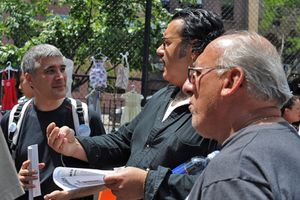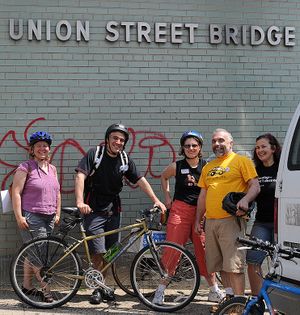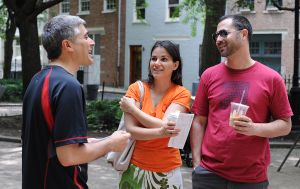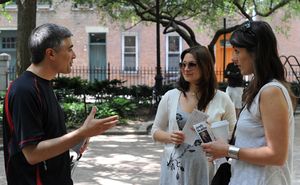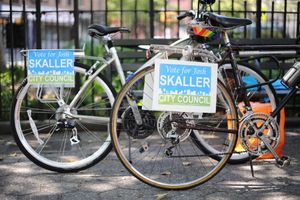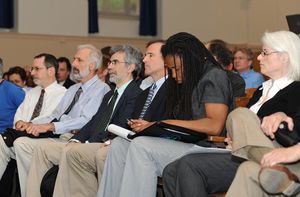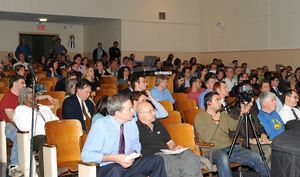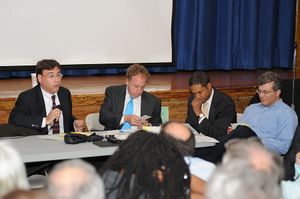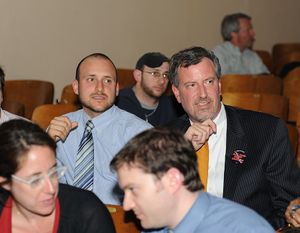
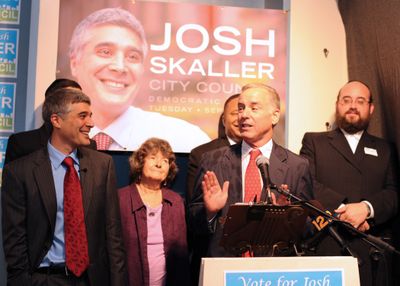
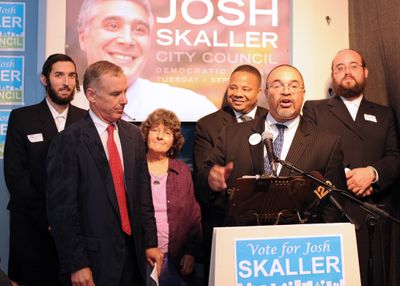 Howard Dean with Josh Skaller meeting commuters near the entrance to the Seventh Avenue F train station. Earlier Dean was in the headquarters of Central Brooklyn Independent Democrats in Park Slope endorsing City Council candidate Josh Skaller.
Howard Dean with Josh Skaller meeting commuters near the entrance to the Seventh Avenue F train station. Earlier Dean was in the headquarters of Central Brooklyn Independent Democrats in Park Slope endorsing City Council candidate Josh Skaller. 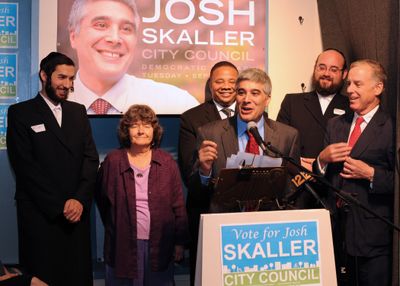
Category Archives: gabriele Gorden: eyes on brooklyn
Gabriele Gorden: Eyes on Brooklyn (Skallerthon)
Superfund Meeting: Who Gets To Clean the Gowanus Canal?
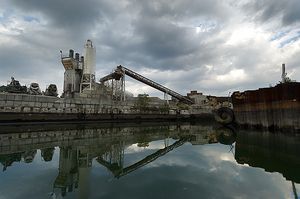 200 people gathered in the auditorium of PS 32 on Hoyt Street
200 people gathered in the auditorium of PS 32 on Hoyt Street
in Carroll Gardens for a presentation organized by the Executive/Public Safety/Environmental Protection/Permits/Licenses Committee of Community Board 6 to hear representatives of the U.S. Environmental Protection Agency on a proposal to designate the Gowanus Canal as a Superfund site.
Also on hand were representatives from the City to discuss the City's alternative plan for the Gowanus clean-up.
Citizens. Reporters. Politicians. Candidates. Neighborhood Activists.
Bloggers. Photographers. Videographers. They were all there and there
was a buzzy, excited and anticipatory vibe in the room prior to the
program.
But once the presentation began, the audience was rapt. Richard S. Bashner, chairperson of Community Board 6, welcomed the crowd and emphasized that "This is not a public hearing. We are not taking comments from the public but we are taking questions."
For starters, the EPA's Angela Carpenter talked about what the EPA found in the Gowanus Canal. And trust me, it's toxic and stinky. The following contaminants were found in very high concentration all along the length of the canal:
–Polycyclic Aromatic Hydrocarbons (PAHs): up to 4.5% in the canal sediment (that's per hundreds)
–Polychlorinated Biphenyls (PCBs): up to 43 parts per million in canal sediment
–Heavy Metals ( Lead, Cadmium, Arsenic and Zinc)
–Volatile Organic Compounds
The presence of these toxic chemicals dates back to the industrial presence that existed along the Gowanus Canal, including Manufactured Gas Plants, coal yards, cement
makers, paint and ink factories, oil factories and the city's sewer overflow that filled the Gowanus Canal for decades.
Carpenter also clued the audience into EPA-speak, numerous acronyms they use almost constantly like RPM (Remedial Project Manager), NPL (National Priorities List), HRS (Hazard Ranking System), RI(Remedial Investigation), MGP (Manufacturing Gas Plants), PRP (Possible Responsible Parties) and more.
You gotta talk the Acronym Talk.
The EPA's Walter Mugdan, director of the Division of Environmental Planning & Protection for Region 2 was the star of the evening. With 30 years experience, he speaks knowledgeably, clearly and with humor and seriousness about a subject that is quite complex.
So what is it that has the EPA so concerned about the Gowanus Canal?
The EPA is concerned about the unbelievably high levels of contaminants in the water and the mud. But they are also very concerned because people fish in the Gowanus.
Yup. They do. And they eat the fish.
And with all the toxins in the Canal that's NOT a good thing. Of course there are advisories in New York and New Jersey telling people to severely reduce their intake of fish.
People also kayak in the Gowanus.
"I would not choose to kayak in the Canal unless you can get into the kayak without splashing water all over yourself and I've never been able to do that," Mugdan said.
So everyone agrees: "You gotta clean the water. you gotta clean the mud," he said. And you've got to clean the upland sources because if you don't do that you're going to continue to have problems whenever it rains.
Mugdan also mentioned that the EPA, with the New York City Department of Health, would conduct a study about the health hazards of living near the Canal. This has never been done.
The question is who gets to clean the Canal?
"There are many ways of skinning the same cat and I'm a cat lover so don't take that the wrong way," Mugdan said. Indeed, what is at issue here is this: Who gets to skin this cat? And from what I learned last night there are three ways to go:
—SUPERFUND, which is paid for by responsible parties (PRPs). In this case, National Grid and those manufactured gas plants. Mugdan emphasized that in NO case is a resident homeowner a PRP and work would begin whether or not the EPA had the money from the PRPs.
According to Mugdan, the EPA is very sucessful at getting the money from PRPs because of high fines and stringent enforcements. "Most cases are settled. We get 100% compliance unless the responsible party is long out of business and bankrupt," Mugdan said. The rest is paid out of the EPA budget.
—ALTERNATIVE TO SUPERFUND is a alternative plan with no Superfund listing. But it is a process much like Superfund and is overseen by the EPA. The EPA requires that the agency that does the clean-up "sign on the dotted line and accept the threat of penalties if they don't get the job done according to the EPA's requirements."
Mugdan seemed to suggest that this option is for those who fear the Superfund stigma.
WRDA: This plan is paid for by the Federal Water Resources Development Act and would utilize the Army Corp of Engineers. It is also paid for by congressional earmarks and taxpayer money. Congress would have to decide whether this was a high priority and getting that congressional appropriation can be dicey. This approach also requires the approval of the EPA.
How Long Will It Take?
"Longer than you wish and less long than you feel," was Mugdan's reply. No matter how you slice it, this is not a quick process. Mugdan thinks the EPA is already ahead of the game because of the data collected by the Army Corps of Enginenrs. It will then take 12 months to do a Feasibility Study. The Record of Decision (or ROD) will take another year. And the actual work to clean the Canal: Mugdan said "It might be a decade. It might be less."
"It's the work that drives the time not the process," Mugdan told the crowd. "There are, however, ways to manage the process to build some efficiencies into it," he said. "But it is complicated for anyone who does the work."
Mugdan seemed to suggest that the WORDA process might take the longest "because you have to get the sufficient funds from Congress and everyone in country is in competition for that money. Congress has authority to do what it wants. Is it politically likely? No one in this room can say."
Mugdan also talked about the important role of the stakeholders, including local residents, community groups, local businesses, and prospective developers. "Their needs need to be addressed. A Citizen Advisory Group (CAG) is a good idea, a monthly group that can assess the process." Mugdan said.
"There are sites where people agree but this ain't one of them," Mugdan added.
So what is it all going to cost?
"$300-400 million. Definitely not $100 million. Probably not $600 million," Mugdan said.
So what does the City want to do?
After Mugdan's virtuosic performance it was time for the City to talk about their approach.
For New York City, Caswell Holloway, Chief of Staff for Deputy Mayor Schyler, took the microphone. It is clear that the City, like the EPA, wants to clean the Gowanus Canal. But they don't want it listed on the National Priorities List and they want to do it in their own "alternative way."
They also want to continue the work they've been doing with the Army Corps of Engineers, who've already collected important data and have begun flushing the tunnel and dredging.
As far as the process: it seems that the City wants is to take a Chinese
Menu Approach: a little Alternative Superfund, a little WORDA and if all else fails they'll take Superfund designation. They want to leave their options open.
"There is no rush to get on the list," he told the crowd. "We can always get on the list if this plan doesn't work." In other words: give the city a chance. You can always go to the EPA if this doesn't work," Holloway said.
Okay.
Here are the City's reasons for an Alternative Plan:
–To maximize existing investments (i.e. Public Place, Toll Bothers, planned re-zoning and work in progress by the Corps of Engineers.
–To avoid being associated with Superfund NPL (National Priorities List). "NPL makes lenders nervous and can draw resources way from the community," Holloway said.
–To not get in the way of plans for Public Place, Toll Brothers and the planned re-zoning.
–To make sure polluters pay, the City wants the polluters to be a key part of the plan. To do this, the city wants to see the voluntary engagement of responsible parties. They'll even give the PRPs a discount if they come forward voluntarily.
"The Army Corps of Engineers is tremendously excited about the Gowanus Canal. It's one of their top 8 priorities. And a voluntary process would be faster than Superfund. Superfund is compulsory and big corporations don't like to be told what to do," Holloway said.
"There is no need to rush the listing. The EPA has the ability to list it whenever they want to. If the city fais, they can list. Now is the opportunity to pursue alternative plan. And EPA doesn't lose ability to list it," Halloway told the crowd.
So how to characterize the two plans?
Superfund: The EPA knows what they're doing. They will start whether or not they have the PRP money. They understand the magnitude of the problem and they won't go away until it's done.
The City: They're already working with the Army Corps of Engineers and want to continue that partnership. They don't want to be stigmatized by a listing on the Superfund Priorities List nor do they want to delay projects that are already in progress like Toll Brothers, Public Place and the rezoning of the Gowanus area. Their's is a "give us a try" approach. It's warm and fuzzy for developers (no delay) and polluters (get a discount if you come forward). Their slogan: "There's no rush to list. You can always get a Superfund listing."
Conclusion: Even the City thinks you can always go with Superfund. So I say why don't we just start with Superfund. It's a great team. They're good to go. We won't have to wait around for earmarks or PRP money. Go for it, EPA. Get that Gowanus clean, clean, clean. However long it takes!

